Bio topic 4 - Biodiversity and Natural Resources
1/94
There's no tags or description
Looks like no tags are added yet.
Name | Mastery | Learn | Test | Matching | Spaced |
|---|
No study sessions yet.
95 Terms
Q1. Has glands that produce waxy lipids to spread over its skin. This reduces water loss. The waxy leaf frog is active only at night, when it hunts for insects in the trees.
(a) (i) Describe how the waxy leaf frog is physiologically adapted to its environment (1)
It has glands that produce waxy lipids to spread over its skin to reduce water loss
Q1. Has glands that produce waxy lipids to spread over its skin. This reduces water loss. The waxy leaf frog is active only at night, when it hunts for insects in the trees.
(ii) Describe a behavioural adaptation of the waxy leaf frog to its environment (1)
Active only at night when it hunts for insects in trees
(iii) Suggest how the behavioural adaptation described enables the waxy leaf frog to survive in this habitat (1)
lower temp at night, easier to hunt for insects / hide from predators
(b) With reference to the waxy leaf frog, explain what is meant by the term niche. (2)
Niche is the specific role (eats insects) of an organism in its habitat (make it specific to question)
*(c) Suggest how natural selection could have given rise to the adaptations shown by the waxy leaf frog (5)
Mutation of gene occurs in a population
Places selection pressure on organisms
Organisms with favourable allele will adapt and survive in survival of the fittest by outcompeting with other organisms for resources
Advantageous gene is passed onto offspring after reproduction
Offspring survive and continue to pass down favourable allele
Q2. (i) State what is meant by the term endemic (1)
When a species is only found in one specific habitat
(ii) Describe what is meant by biodiversity (2)
Variety of species that occupy a habitat with a variety of alleles in gene pool
(iii) Explain how the biodiversity of lemurs in two different parts of Madagascar could be compared (3)
Calculating heterozygosity index by counting no. of individuals in the different parts of Madagascar
the higher the index the higher the biodiversity
Count no. of organisms of particular species and total no. of organisms of all species
Q5. In the 1970s, a theory for a new system of taxonomy was proposed by a scientist called Woese. Describe the process by which the scientific community critically evaluates new theories. (3)
Scientist proposes a theory to scientific community / Theory is published in scientific journals / conferences
Theory is peer reviewed by other scientists
check evidence to ensure validity
Q6. (i) Suggest why successful interbreeding between chiffchaffs and willow warblers would make some scientists doubt their classification as separate species (3)
Successful interbreeding produces offspring
Same species produces fertile offspring
credit reason why offspring of different species might be infertile
(ii) Suggest reasons why the two species don’t interbreed (3)
Reproductive isolation
Different breeding times
Physically incompatible
(b) Suggest why the rate of change in the appearance of these two species is relatively slow (3)
Lack of changes to environment
2 species share the same habitat
2 species experience same environmental conditions
therefore same selection pressures
Both well adapted to environment
No mutations have happened that improves their phenotypes/survival
Few changes in allele frequency/gene pool is stable
(ii) Describe how to carry out a study of the distribution of Epilobium latifolium from the front edge of this glacier (4)
Sample along transect line
Count no. of latifolium in quadrats
Use systematic sampling
Use more than one transect
Record results on a graph
(iii) Suggest one abiotic factor that might affect abundance of Epilobium latifolium and describe how this factor could be measured (3)
Light intensity
Use light probe
take several readings for an average
Q4. (ii) The Scottish wildcat can interbreed successfully with domestic cats. Explain the effect this could have on the genetic diversity of the Scottish wildcat (2)
Increases genetic diversity / size of gene pool
due to introduction of new alleles into population
Q6. (i) State what is meant by the term allele (1)
Different version of a gene
Q8. (ii) Herbicides are sprayed on lawns to kill unwanted plants. Explain how the calculated value would change if a herbicide was used on this lawn (2)
Value will decrease due to fewer species present
Q9. * The graph shows the changes in the relative abundance of pollinating wild bee species in the UK. The original sample in 1980 represents a value of 100%. Explain how the changes in the relative abundance of bee species in the UK may result in the development of a new species of bee orchid (6)
Population will reduce due to increased self-pollination
Populations that self-pollinate will still produce some variation in their offspring
This variation will be reduced as only one parents’ alleles are used
Genetic drift may occur
Similarities to E. longicornus may not be as obvious as there’s no advantage / selection pressure to look like a bee
Chance of different gene pool leading to formation of 2 new species
Lack of E. Longicornus in areas of the UK will increase chance of new species of bee orchid developing there
Q13. Information on biodiversity has been collected from various rainforest habitats in Madagascar. (i) Describe what needs to be measured in order to compare biodiversity of two rainforests (2)
Counting no. of different species / measuring species richness
Counting no. of individual per species
(ii) Analyse the data to determine the importance of the rainforests of Madagascar in maintaining biodiversity on Earth (3)
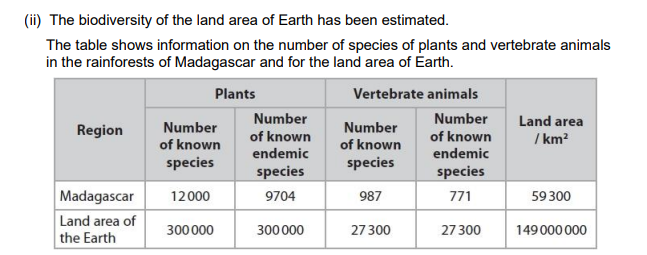
Percentage of world plants found in Madagascar (4%)
Species density of plants in Madagascar is higher than for Earth / large no. of species relative to the area
Many of the species found in Madagascar aren’t found anywhere else

Q15. The map shows the distribution of two species of sloth. There are currently two major populations of C. hoffmanni in South America. B. pygmaeus is restricted to an island off the coast of Central America. Each population occupies different habitats. Discuss why the number of sloth species may change in the future (6)
May increase due to -
Geographical isolation
Different selection pressures on populations of C. hoffmanni
Different allele frequencies within separate populations
Evolution leading to formation of new species
May decrease due to -
B. pygmaeus is currently critically endangered
Only one population therefore could be vulnerable to inbreeding depression
At risk of natural disaster, disease, predation etc therefore may become extinct
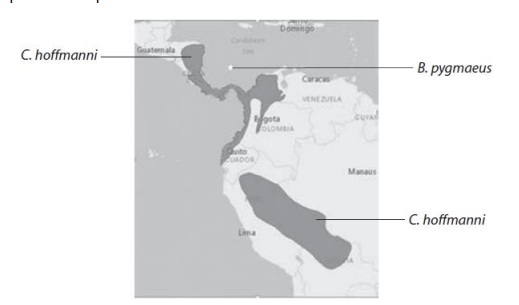
(ii) To decide which of the two link roads should be built, studies of the biodiversity of woodlands P and Q need to be carried out. Discuss what information needs to be collected from the two woodlands to make a decision about the site of the link road (4)
Biodiversity measured using diversity index
Assessing species richness / counting no. of diff species in an area
Genetic diversity of populations / species
Presence of any endemic / rare species / endangered species
Q18. Explain how the primary structure of trypsin molecules can be used to produce a phylogenetic tree (3)
Determine sequence of aas for trypsin
Determine no. of similarities / differences in sequences of aas between species
More similarities = more closely related
Greater difference in sequence, longer the time to form common ancestor
Q19. Explain how these two species of snake could have arisen from a common ancestor (4)
Mutation leads to variation within population of grass snakes
Natural selection led to snakes better camouflaged surviving to reproduce therefore giving rise to 2 populations with differing allele frequency
As a result of natural selection, the 2 populations became reproductively isolated / can’t breed with each other
Sympatric speciation (in the context of new species developing in same habitat)
Q20. It is believed that C. hoffmanni and C. didactylus shared a common ancestor before becoming isolated on either side of the Andes mountain range. (i) Explain why they are now classed as different species (2)
Reproductively isolated so can’t interbreed to produce fertile offspring
Q22. (ii) Over time, the Brownsea Island population of squirrels might develop into a new species. Name the process that could lead to the Brownsea Island population of squirrels becoming a new species (1)
Natural selection / reproductive isolation
Q27. (ii) Scientists took blood samples from infected red squirrels and analysed them using an electron microscope. Describe the features that could be used to identify the prokaryotic cells in the blood sample (4)
Presence of a cell wall
Contains plasmids / circular DNA
Contains pili
Contains 70S ribosomes instead of 80S ribosomes
Contains capsule
Q28. (i) Explain why the percentage of elephants without tusks in Mozambique will probably increase in the future (3)
Many were killed for their ivory / Large percentage of population don’t have tusks
Elephants w/o tusks were more likely to survive and breed
therefore passing on alleles for not having tusks
increasing frequency of homozygous recessives in population
(ii) Describe how the Hardy-Weinberg equation can be used to provide evidence for changes in the elephant population in Mozambique (2)
Calculate allele frequencies / no. of dominant and recessive alleles in Mozambique population
Regular sampling over a period of time
Q30. (i) Explain how molecular phylogeny can be used to show that these two populations are reproductively isolated (3)
Comparing similarities and differences in DNA / proteins
Comparing nucleotide sequences / aa sequences
More differences = more likely they are reproductively isolated
(ii) Describe how mutations in badgers to the east of the Bosphorus Strait may lead to this population becoming a separate species (4)
Mutations result in production of new / different alleles
Selection pressures cause alleles to be advantageous
More individuals with advantageous alleles survive and reproduce
After time, population won’t be able to reproduce with other badger species to produce fertile offspring
Q31. * (iii) Analyse the data to explain how malaria has affected the percentage of individuals in the Yoruba population with the allele for sickle cell anaemia. (6)
Sickle cell anemia more frequent in areas where malaria is also found
HIghest proportions of populations with allele for sickle cell anaemia are in areas where there’s malaria
Yoruba people live in an area where P.falciparum is found
Malaria can be fatal and acts as a selection pressure
Individuals heterozygous for sickle cell anaemia more likely to survive malaria
These individuals pass on alleles for sickle cell anaemia to offspring
Over time no. of individuals in population with alleles for sickle cell anaemia has increased
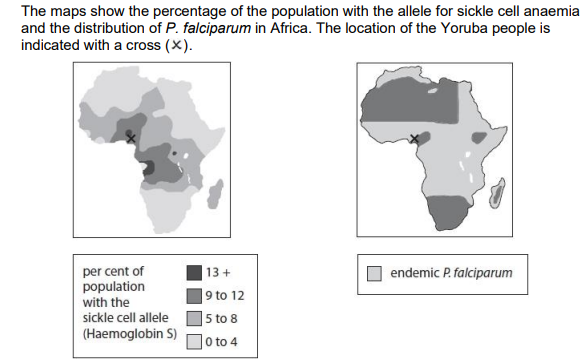
Q32. Scientists measure biodiversity using both species richness and the heterozygosity index. State what is meant by the following terms (2)
species richness
heterozygosity index
Species richness - measures no. of species in a habitat
Heterozygosity index - measure of genetic diversity within species / population
Q33. State what is meant by the term species (1)
A group of organisms that can interbreed to produce fertile offspring
Q37. (i) Explain how this diagram indicates that saiga antelopes are more closely related to Antilope than to Antidorcas (2)
Saiga more closely related to Antilope because they shared a common ancestor more recently
There are more similarities in the protein / similar sequences of aas

(ii) This is a more recent classification diagram based on a study of the mitochondrial genomes of antelopes. Deduce how this study led to different opinions about the relationship between Saiga and Antilope (3)
They’re less closely related
DNA profiling comparison detected more differences in mitochondrial genome
Q39. Explain how molecular phylogeny could be used to determine the relationships between the Scottish wildcat and other subspecies of European wildcat (2)
Compare sequences of bases in DNA / aas in proteins
More similarities = more closely related the subspecies
/ More recently evolved from common ancestor
Q1. Using the information in the photograph and your own knowledge, describe the structure of a cellulose cell wall (3)
Cellulose is a polymer / chain of beta glucose
Cellulose molecules held together by hydrogen bonds as microfibrils
Microfibrils arranged in a parallel / net mesh / criss cross
Matrix / Hemicelluloses / pectin
Q2. (a) Name three structures present in prokaryotic cells but absent in animal cells
Plasmids
Circular DNA
70S ribosomes
Capsule
Pili
Mesosome
Q3. (i) Name the monomer that makes up cellulose (1)
Beta glucose
Q5. Explain what is meant by tissue (2)
One or a few cell types / group of cells working together for the same / specific function
Often have the same origin
(ii) Describe the functions of xylem (2)
Transport of water / minerals
Structural support
*c) Describe the structure of a cellulose microfibril (4)
Cellulose contains beta glucose molecules joined by condensation reactions by 1-4 glycosidic bonds
Inverted alternate glucose molecules in the chain
Contains unbranched / straight chain
Microfibril composed of many cellulose molecules
Cellulose chains held together by hydrogen bonds
Q6. Explain the effects of a shortage of magnesium ions on a plant (3)
Limits production of chlorophyll
Lack of glucose due to less photosynthesis
therefore plant leaves may be yellow / stunted growth
Q7. (ii) Explain why starch must be broken down before it can be used by the cells of the gro plant (2)
To produce glucose / maltose
which is soluble / transported / enters cells easily / used in respiration
Q3. (ii) Explain the relationship between the structure and functions of a granum in photosynthesis (3)
Stacks of thylakoids provide large surface area
Thylakoid membranes contain chlorophyll to absorb light
Electron carrier molecules in thylakoid membrane involved in ATP production / Photophosphorylation
Q4. (ii) Describe how nitrate ions are transported from the root to the leaves (2)
Through xylem in water
Q6. Compare and contrast the structure of chitin with that of a cellulose molecule (3)
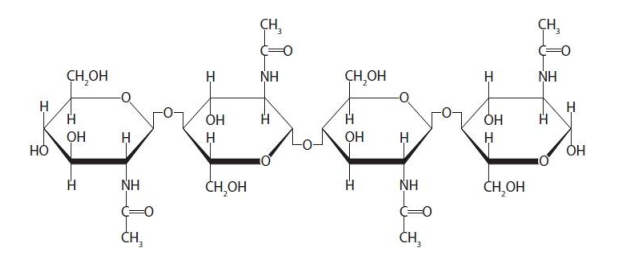
Both have glycosidic bonds
Both have every other glucose is inverted
Monomers of chitin have 8 carbon atoms whereas cellulose has 6
Chitin has an additional side chain / contains nitrogen but cellulose doesn’t
Q7. (ii) Compare and contrast the structure of cellulose and amylopectin (3)
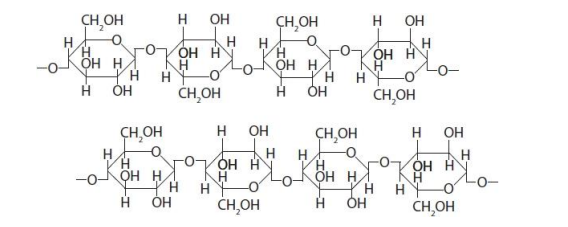
Both are polysaccharides
Both contain 1-4 glycosidic bonds
Cellulose contains 8 beta glucose whereas amylopectin contains alpha glucose
Cellulose isn’t branched / doesn’t contain 1-6 glycosidic bonds
Q8. Devise a valid investigation to determine the effect of storage temperature on the tensile strength of manila rope and nylon rope (4)
Gather ropes of same length and width stored at range of temps above and below 18°C
Store ropes for same period of time
Apply masses / force until rope breaks
Calculate change in tensile strength
Q9. Describe how the tensile strength of these fibres could have been measured (3)
Add 50g bamboo fibre to same mass of resin
Tensile strength tested by adding masses until the fibre breaks
Calculate tensile strength by dividing force by cross-sectional area
Control temperature
Q10. (i) Cellulose and amylopectin are polymers of hexose sugars. State one difference between the hexose in cellulose and the hexose in amylopectin (1)
Amylopectin contains alpha glucose and cellulose contains beta glucose
(ii) The cellulose molecules form microfibrils. Name the bond between adjacent cellulose molecules in a cellulose microfibril (1)
Hydrogen bond
Q12. (a) Explain why the seedling needs a supply of magnesium ions (2)
To make chlorophyll for photosynthesis as shoots need chlorophyll to carry out photosynthesis to grow
Q13. Comment on the effects of deficiencies in magnesium ions and calcium ions on the growth of these rice plants (4)
Effect of magnesium deficiency is shown earlier than effect of calcium as first leaf to die is leaf five in Group B plants
Plants continue to grow in solution lacking magnesium
Plants stop growing in solution lacking in calcium
W/o calcium for middle lamella leaves are stunted
Q14. Devise an investigation to determine the effect of nitrate ion concentration on the growth of young peanut plants (5)
Gather plants of same age
Add a range of 5 different nitrate concentrations
Control temperature
Leave plants to grow for 1 week
Record growth by measuring plant height
Repeat at each nitrate concentration to calculate mean values
Q18. Explain the role of the middle lamella when a plant cell completes mitosis (2)
Produced between adjacent new cells in cell plate because middle lamella holds cell walls together
Q21. Give two reasons why a sieve tube element does not require rough endoplasmic reticulum and ribosomes (2)
No transcription therefore ribosomes not required
No proteins will be synthesised in ER / proteins are provided by companion cell
Q22. Plant-based products provide a sustainable alternative to oil-based plastics. A sustainable alternative is a plastic material that contains more than 30% plant-based polymers.
(i) Describe the structure of starch (3)
(ii) Explain why this plastic material is only partially sustainable (2)
(i) Starch is a polysaccharide made up of alpha glucose molecules joined together by 1-4 glycosidic bonds
Starch contains amylose and amylopectin
Branches are joined to chains by 1-6 glycosidic bonds
(ii) Starch comes from plants that can be regrown however not 100% starch so some oil-based products needed
Q24. (ii) The electron micrograph shows a difference in the number of mitochondria in the sieve tube element and in the companion cell. Explain the difference in the number of mitochondria (3)
CC has more mitochondria
Role of ST is to provide a channel, so cellular contents are kept to a minimum
ST has limited / no ability to carry out aerobic respiration
ATP / energy is supplied to ST from CC
Q25. State what is meant by the term tensile strength
Pulling force fibre can withstand before breaking
Q26. Tensile strength can be tested using different methods. One method is to attach both ends of a fibre to clamps horizontally and hang increasing numbers of masses until the fibre breaks.
A second method is to attach one end of a fibre to a clamp and the other to a forcemeter, pulling on the forcemeter until the fibre breaks.
Explain which method will give more accurate results (2)
2nd method more accurate as exact value will be shown on forcemeter
1st method less accurate because true value will be between 2 masses
Q30. Tissues that contain lignin provide strength to plant fibres. Describe the positions in the stem of those tissues that contain lignin (2)
Sclerenchyma fibres outside vascular bundle
Xylem in vascular bundle
Q31. Describe the importance of magnesium ions in the production of plant fibres (2)
To produce chlorophyll for glucose during photosynthesis
Glucose needed to produce cellulose for cell walls
Q32. Kapok produces seed pods containing waxy fibres made of cellulose covered in lignin.
(i) Describe the arrangement of glucose monomers in a cellulose molecule (2)
(ii) Devise a method to find the relationship between the actual diameter and the tensile strength of kapok fibres (6)
(i) Monomers connected by 1-4 glycosidic bonds
Alternate monomers inverted
(ii) Extraction of individual fibres from seed pod
Diameter of fibre measured using microscopy
Control temperature
Clamp fibres and hang masses from fibre
Add increased mass at regular intervals until fibre breaks
Repeat to find a mean at each diameter
Divide force by cross-sectional area
Q1. Give four reasons why a contemporary drug testing protocol is an improvement on the trial used by William Withering (4)
Safer - pure drug used rather than extract / pre-testing on cells / animals before humans / regulated by legislation
More valid - placebo used as comparison / modern testing involves double-blind trials / controlling variables tested cohort (age)
More reliable - more ppl are tested / results analysed statistically
Q3. (a) (i) State what is meant by species richness (1)
no. of species in an area / habitat
(ii) Suggest what effect the extinction of the shiny nematolepis plant would have on species richness in South East Australia (1)
reduction in species richness
(c) Shiny nematolepis seeds had already been stored at the Millennium Seed Bank at Kew. These seeds were used to restore this plant species and to ensure its survival. (i) Explain how these seeds were selected for storage in the seed bank (3)
from different plants to provide genetic variation and check for viability + x-rayed
(ii) Describe the conditions used for the storage of seeds in seed banks. Explain why seeds are stored in these conditions (3)
dry and cold to prevent enzyme activity and germination of seeds / decay
Q4. (i) Explain why healthy volunteers were given different doses of the drug or a placebo (2)
to check for side effects
placebo was to make sure any side effects were due to drug
different doses to determine safe dose
(iii) Compare and contrast this drug testing protocol with that used by William Withering he tested digitalis soup. (3)
Both trials used different doses to determine safe dose
William Withering didn’t use healthy volunteers
William Withering didn’t use a placebo while this trial did
Q5. SGSV keeps seeds from more than 865 000 varieties of plant, including 200 000 varieties of wheat and rice. Some of these varieties are rare or extinct in the wild.
Justify the continued funding of SGSV (3)
SGSV conserves genetic diversity of crops
Crop varieties kept in SGSV are protected from natural disasters / drought which can threaten varieties grown by farmers
Crop varieties in SGSV may have traits that are useful in the future such as drought or pest resistance
SGSV helps ensure food security
Q6. (a) Suggest why the production of oil from Canola seeds can be described sustainable (2)
renewable
resources can be made available for future generations
more Canola plants can be grown
Q7. The use of plant fibres is more sustainable than the use of synthetic fibres made from fossil fuels. Give reasons why (2)
More plants can be grown
Plants are a renewable resource
Q1. Describe one advantage and one disadvantage of using ropes made from plant fibres rather than ropes made from oil-based plastics (2)
Advantage - sustainable
Disadvantage - can decompose / less strong
Q4. Describe two aseptic techniques that should be used when working safely with bacteria (2)
Washing surfaces with disinfectant before and after working
Disinfect instruments
Only opening the agar plate lid slightly / keeping lid off for minimum time
Q5. Explain why some bacteria can grow rapidly in skin wounds (3)
Temp is warm, increasing the rate of reactions in bacteria
Availability of energy source from tissue / blood
Availability of water for bacterial cell functions
o2 availability is good, allowing aerobic respiration
(ii) Describe how to test whether the salve is an appropriate treatment for humans with wounds infected with S. aureus (4)
Treat one group of patients with the salve and another with an existing treatment
Apply salve to healthy humans
Neither doctors nor patients involved in the trial should know which treatment is being used
Participants must be monitored for side effects
Compare outcomes of patients treated with salve and control group
Q6. Explain how breeding programmes in zoos maintain the genetic diversity of captive populations (3)
Animals are selected to prevent breeding between closely related individuals / inbreeding depression
A stud book is used to select individuals for mating / prevent inbreeding
Exchange of animals between zoos
Q9. (i) Explain why healthy volunteers were given different doses of the drug or a placebo (2)
Small groups of healthy volunteers given vaccine to test for side effects
Healthy volunteers tested for presence of antibodies to the virus following vaccination
A group of people at risk of contracting the disease is given the vaccine
No. of ppl who develop the viral disease following vaccination are monitored
(ii) Justify the use of this vaccine, even though the clinical trials hadn’t been completed (4)
Large numbers of people died from the disease
Health workers are in close contact with people suffering from the disease
The side effects of the vaccine will not be worse than contracting Ebola
Vaccinating immediate family will help to reduce spread of disease
If health workers were vaccinated they could care for more people
Q12. *(ii) The following comments refer to other issues concerning the conservation of orangutans in Borneo.
• Over the past 100 years, 80% of suitable habitat for orangutans has been lost. • Only 2% is protected.
• From 1999 to 2015, the orangutan population decreased by 50%.
• Captive-bred orangutans may spread human diseases into wild populations.
• When captive-bred orangutans are released, their offspring often die young because the females have not learnt parenting behaviour from older individuals. • Large numbers are hunted + It has been stated that habitat protection is more important than captive breeding programmes for conservation. Evaluate (6)
Orangutan numbers are declining and captive breeding will increase population size
Captive animals will be protected from hunters, it’s important to restrict passage of disease from humans to the wild population by minimising contact and releasing animals away from wild populations
As loss of habitat is major reason for the decline, animals should be released into areas of forest in protected areas
More of the forest needs to be protected to reduce the rate at which habitat is being lost
Captive bred animals show behaviour that make them unable to complete in wild
Deforestation is reducing the habitat which leads to increased competition due to reduced food availability
If deforestation isn’t reduced, there won’t be enough habitat left to release captive-bred orangutans
releasing animals if there’s insufficient habitat could lead to an increased vulnerability to predation and poaching
Q13. Describe how aseptic techniques are used when handling bacterial cultures (3)
Working bear a bunsen burner to provide convection current
Sterilising work surfaces
Sterilising equipment with heat / flame inoculating loops
Only partially lifting lids from petri dishes
Q15. Explain the role that a placebo and a double blind trial have in producing valid conclusions (4)
Placebo - provides control group for comparison ensuring active ingredient is causing the effect
Double blind trial - neither doctors nor patients know who has been given the actual drug ensuring bias is removed from the trial
Q17. Devise a procedure that scientists may have used to measure the effects of the extracts of pathogenic bacteria (4)
Produce agar plates with bacteria
Filter paper discs used to add plant extract to plates
Extracts used separately and in combination
Incubate at 37 c for 24 hours
Measure and compare the sizes of zones of inhibition
Q19. (ii) Explain why the agar plate was incubated at 25 °C (2)
To allow bacteria to multiply without encouraging pathogenic organisms
Q20. (i) Explain the advantages of drying seeds before storage (2)
Extends storage time of seeds because drying prevents germination / decomposition of seeds
Q20. Many of these plants have potential medical uses. Predictions from initial research suggest that seeds from 80% of flora in Boyacá will survive the drying process.
(ii) Justify the benefits of conserving seeds from Boyaca (2)
prevent species from becoming extinct
conserving species with potential medicinal properties
safeguarding genes that may prove useful in the future
allow for reintroduction of species (in the future)
Q21. Explain why bacteria are able to multiply in the bloodstream when they enter the body (3)
warm conditions / water available
Suitable temp for bacterial enzymes
Glucose used for respiration
aas used for growth
Q22. Explain why the use of bamboo fibres to make coffee cups is sustainable (2)
available to future generations because bamboo is a renewable resource because more bamboo plants can be grown
Q25. Describe the roles that zoos play in animal convservation. (3)
Protection from poachers
Increases numbers / releases back into wild
Improves health / discovering better nutrition / developing genetic database
Educates about conservation
Q30. A number of seed banks have been set up around the world. When a seed bank receives new seeds, it processes them in several ways. The processes can include the following stages:
• washing the seeds with disinfectant
• allowing the seeds to dry.
Explain the advantages of these two stages. (3)
Washing with disinfectant will kill any microorganisms
Drying to reduce chance of germination / decrease enzyme action
therefore preventing decay to seeds
Q35. Explain why the production of fibres from nettles is more sustainable than fibres produced from crude oil (3)
Nettle plants can be grown so they’re renewable
Crude oil is non-renewable and will run out
Use of fibres from nettles will be avilable to future generations
Clothing made of nettle fibres is biodegradable
Q37. (ii) Describe how the safe dose of a cancer drug could be determined. (3)
Test drug on healthy individuals then individuals with cancer
Gradually increasing dose to determine dose that doesn’t reduce ventricular ejection fraction / determine dost that doedsn’t cause side effects